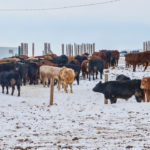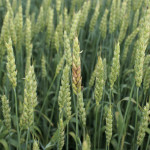Reading Time: 3 minutes Variable weather conditions across the Prairies could cause problems with mycotoxins in feed this winter. “The No. 1 most influencing factor in mycotoxins is weather,” said Max Hawkins of Alltech’s mycotoxin management team. “Weather determines which moulds we’re going to have, the amount of those moulds, and those moulds determine the variety of mycotoxin.” Mycotoxins […] Read more

Mycotoxin risk likely to be high in some Alberta feed grains
Last year’s growing conditions created a perfect breeding ground for some dangerous mycotoxins, including DON

Mycotoxins — the invisible danger for livestock
Ruminant nutritionist offers tips to ensure feed doesn’t pose a health hazard to your cattle
Reading Time: 3 minutes Mould and mycotoxins can be tricky, but there are a few tips that can help prevent them from hurting your cattle. That was the message that Amanda Van De Kerckhove, ruminant nutritionist with Co-op Feeds, brought to Northlands’ first BeefTech event. “It can be a little overwhelming when you look at all the factors that […] Read more

Tips when feeding unharvested crops
Digestibility, nutrient levels, and presence of mycotoxins are factors to consider before swath grazing or baling
Reading Time: 2 minutes Using overwintered cereal crops for swath grazing this spring — or baling for use as greenfeed next fall and winter — is an option but raises some concerns. “Typically, protein and energy contents are lower in the spring compared to the fall,” said provincial beef and forage specialist Barry Yaremcio. “Digestibility of the feeds can […] Read more

Toxins could be present in ensiled corn
Reading Time: < 1 minute Watch for the presence of mycotoxins when feeding ensiled corn. When the toxins T-2, HT-2 and DON (vomitoxin) are present, cattle will reduce the amount of feed they eat, said provincial veterinary toxicologist Joe Kendall. “However, if you ensile the standing crop with the mycotoxins present, you are mixing good and contaminated feed together so […] Read more

Don’t let down your guard when it comes to fusarium
Provincial crop specialist says seed testing and using seed treatment are critical
Reading Time: 2 minutes Fusarium head blight outbreaks can cause significant losses in grain yield and grain quality, while also resulting in the production of mycotoxin-Deoxynyvalenol that affects livestock feed, the baking and milling quality of wheat and the malting and brewing qualities of malt barley. That’s why producers need to be vigilant, even if its rate of infection […] Read more

Canada to check India’s feed corn for aflatoxin
All feed corn coming to Canada from India is now going to be held and tested for aflatoxin, as high levels of the toxins have recently turned up in organic corn from the country. Importers of corn — organic or otherwise — from India, starting immediately, first must sample the corn, upon arrival in Canada […] Read more

Wheat buyers pumped when Alberta farmers visit
Wheat buyers have all kinds of questions from mycotoxins and food safety to supply and crop data, and they also want to meet growers in person
Reading Time: 4 minutes When Lynn Jacobson went to Asia on a trade mission, he found his preconceived notions were completely wrong. “My preconception of what society was like over there was completely changed,” said the grain farmer from Enchant. “I thought they were 10 to 15 years behind us, but in some ways they’re 10 to 15 years […] Read more

Ergot becomes invisible in manufactured feed
Researchers and feed makers say new guidelines for assessing risk are needed
Reading Time: 2 minutes The two pictures of pelleted feed veterinary toxicologist Dr. Barry Blakley put up on the screen at a recent ergot symposium here looked identical. But one had enough toxins in it to kill livestock. The rising levels of ergot in western Canadian cereal grains and forages has turned into a nightmare for the manufactured feed […] Read more

